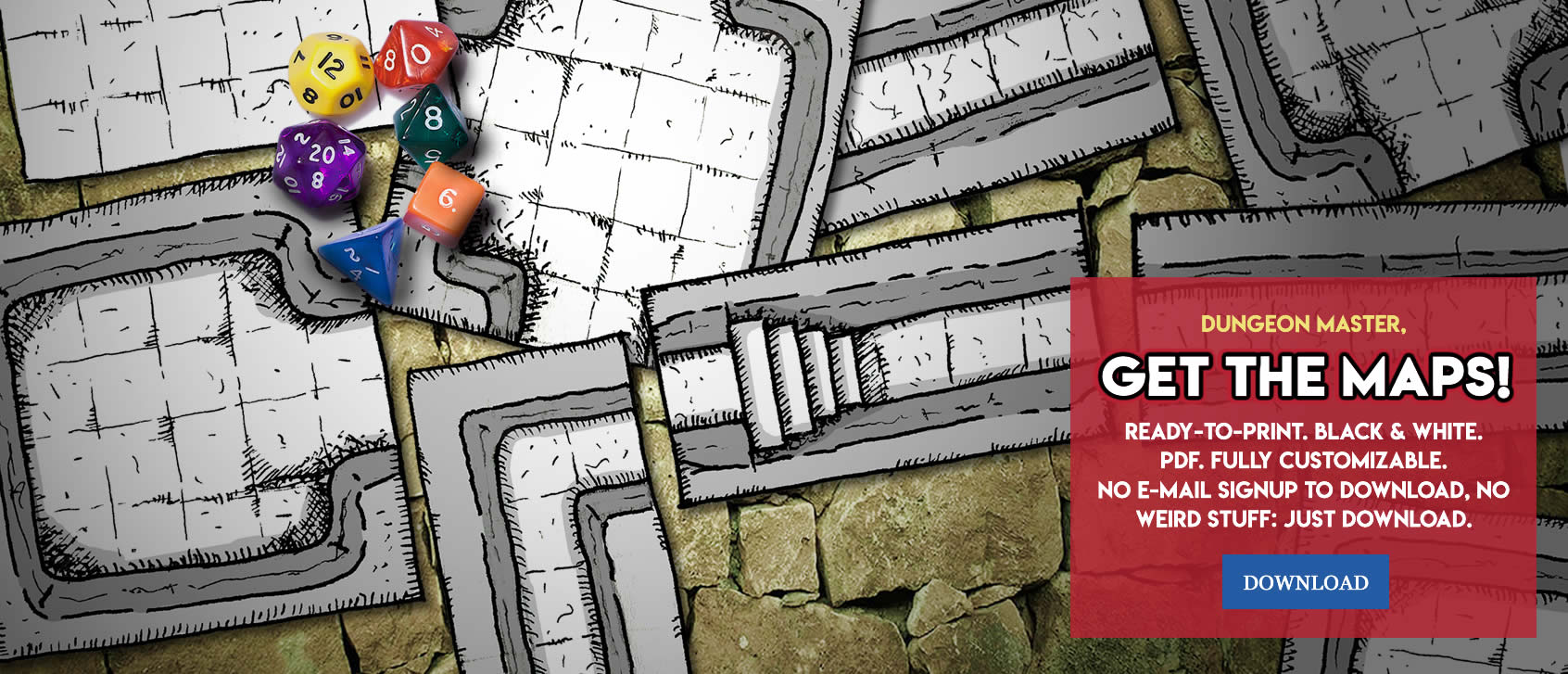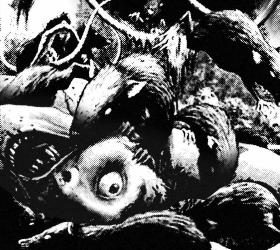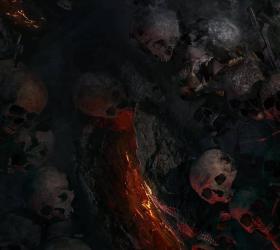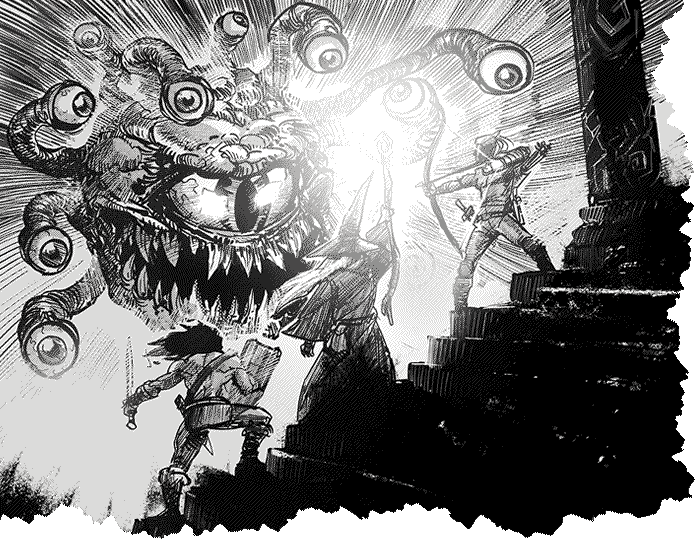
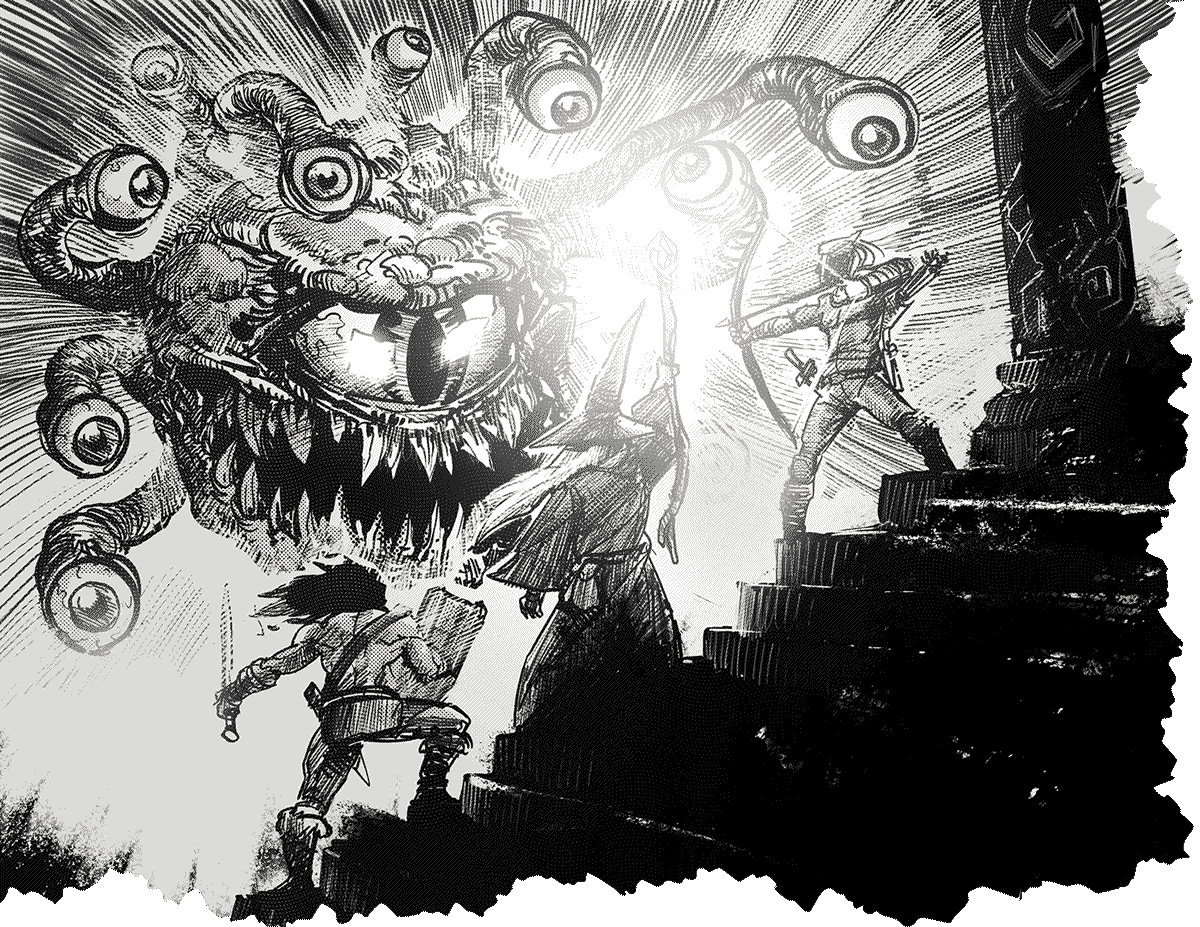
The Tower of the Beholder
Something sinister is rumored to be happening in the small fishermen village of Leda. Children are disappearing from their mother's beds without a trace, without a sound heard...
Welcome to the first edition of “Dungeon Master”, our little corner dedicated to the pen and paper gamers! With each new issue of The Free Bundle there will be a new and exciting adventure to play. Sword and Sorcery, Call of Cthulhu, Vampire, Pathfinder, you name it!
Our pledge: to make your life as a dungeon master easy with fully customizable, ready-to-play adventures. That means printable maps, location descriptions, and everything to enhance and the adventure.
A warning: Your players may be seasoned adventurers, but we assure you: nothing of what they have experienced so far comes close to what they will go through with The Tower of the Beholder. There will be difficult decisions ahead for those who dare to venture inside the tower of the old abbey. Decisions that, without a doubt, will follow them and their characters through many campaigns. Consequences, that no one on your table will forget.
INTRODUCTION
The children of the coast of Leda, at the south of Whitesparrow, have begun to mysteriously disappear from their beds during the night. Lord Fargus, sovereign of those lands, suspects that the Tower of the Beholder, an old construction bordering the ruins of his father’s old abbey, might have something to do with the disappearances.
With villagers on the verge of a revolt, Fargus was forced to send six of his best men to the tower for answers, but none has returned.
Now, as despair grows among the fishermen and his remaining men, no one dares to leave their families alone to investigate the tower. Lord Fargus fears a revolt like the one that killed his father is in his hands.
As if the traceless fading of Leda’s children was not enough poison in the lips of men, rumors about the curse have begun to spread throughout Whitesparrow, affecting the economy of the small village. People in nearby cities refuse to trade with Lord Fargus’s fishermen, even though they have never heard of missing children: Leda’s fish have soured. Its meat tastes rotten.
Hunger and fear have driven many of the villagers to flee. Some leave Fargus’ lands on foot, others by caravan, but in the end, it doesn’t matter: few make it past the hills. No town will have them. Not while they bring the curse of the missing children.
To add your own hazards and traps, please make use of the following guidelines. These determine the Difficulty Class for ability checks, hit points for your inanimate objects, and damage thresholds.
Skill DCs: 10 (easy) to 20 (hard)
Hit Points: 5 to 30
Low Damage: 3 (1d6)
Medium Damage: 7 (2d6)
High Damage: 14 (4d6)
SUMMARY OF THE ADVENTURE
This adventure begins when the players bump with a caravan of two families on the road. They are trying to repair one of their wagon wheels so they can return to the small fishing village of Leda before nightfall.
The families, like many others attempting to escape “the curse of Leda”, have been met with hostility and even with violence when trying to set up camp at the outskirts of the nearby towns, being forced to return.
Although the fisherman families are willing to share some aspects of the mystery of the missing children that afflicts their people, their bitterness and frustration make them extremely reserved, so they will keep their distance with the players.
Once in Leda, the players will notice a predominantly rotten smell in the narrow streets of the village. Its beaches are full of rotten fish. They will try to speak to other fishermen to learn more about Fargus’ story and the missing children, but it won’t be easy: the locals, tired of ridicule and disdain from all of Whitesparrow, will have few words for them. Shame and fear seem to speak louder than hospitality.
While there is little that the party can gather from the villagers, something is clear: people there suspect that Cassandra, the banished sorceress of Lord Fargus’s father, has something to do with the disappearances. Lately, many have seen her roaming near the cliffs at night. For the villagers, their return to Leda is what has caused the disappearance of the children, and the rotten fish with which the sea keeps feeding them. The witch is taking revenge.
After all, it was they who hanged her lord and murdered her pet, a Beholder.
This will be the first time that players hear about a Beholder in Leda, and although they can certainly try to know more about how and why its there from the villagers, no one will want to say much about it.
Eventually, the party gets an invitation to the “mead hall”, where they will meet a devastated Lord Fargus, sovereign of Leda, sunk into desperation and decadence. Fargus, like any leader about to lose his position, promises the party what’s left of his fortune (which is not much, but enough to make the players agree to the adventure) if they enter the Tower of the Beholder.
The Tower, an old watchtower of the abbey, is where the sorceress of his father raised a Beholder to protect the village during the campaigns of Rahinne, and where he suspects may lay the answer to the problems of his people.
Almost moved to tears, Fargus begs them to find out what happened to his men and help him unravel the mystery of the rotten fish and missing children of Leda once and for all.
What everyone knows but nobody will tell the players or Lord Fargus, is that ten years ago, in their miserable hunger, the starving villagers revolted against Fargus’ father, broke into the abbey and feasted on the children of the beholder. Then, hanged Fargus, ransacked the place and set everything on fire, with everything and which inside.
The beholder barely escaped the flames but ended disfigured, and upon seeing how the villagers devoured his children on the way out, he went mad.
For the next ten years, as much as the beholder tried to avenge his children, he simply couldn’t: the witch had cast a protection spell, keeping him away from the villagers.
What the players won’t know until the end of the adventure, is that ten years ago, in their miserable famine, the villagers mutinied against Lord Fargus, broke into his abbey and feasted on the Beholder’s offspring, Then, they hung their Lord and set the abbey on fire, with the witch inside.
The flesh that the villagers eat that night corrupted their lineage. The curse they cast upon themselves passed onto the womb of their women and from there, to the children they women carried.
It has been their children who paid for the parents’ sin. They were born dead, soulless. For they are neither human nor creature: they are monstrosities. Things that shouldn’t exist. Things that carry a disease that needs to be kept from spreading.
If they kept their human shape for as long as they did it is because the spirit of Cassandra has been protecting the people of Lord Fargus from the beyond. Even after all these years, even after what they did to her and her Beholder.
But the magic of Leda’s sorceress has begun to fade away out of this plane, leaving the children unprotected from the beholder’s disease. Without Cassandra, not only the children’s curse will continue its course, but also the one of the sea’s; for it hasn’t forgiven yet the fishermen for feeding the aberration with its fishes.
The players will have to face not only the missing children, which are now aberrations, but also a crazed Beholder, who will unleash his contained fury on anyone who tries to snatch his new children away from him.
Enemies: Poisonous Vine, Giant Spiders, Beholder, Three Zombies, Missing Children, a Rust Monster, a deep gnome, a Shrieker, a Skeleton, and a Giant Centipede.
NOTABLE NPCS
Lord Fargus: Sovereign of the small fishermen’s village of Leda. Fargus and his father share the same name, something not too uncommon among those ruling Whitesparrow. During the Rhainne campaigns, Lord Fargus’s father was hanged from the great oak tree near his old abbey by a mob of hungry fishermen.
At the time, Lord Fargus’s son was in the battlefront when rumors about the hunger and discontent of his people reached his ears. For six days and their nights, Fargus’s Son rode back to aid his father, though by then it was already too late.
Now, with the children disappearing and the seas giving rotten fish again, Lord Fargus suspects of his father’s old witch, Cassandra, who vanished in the middle of the revolt ten years ago, leaving his Lord to his luck.
Many believe to have seen the witch near the roads during the cold winter nights. To Fargus, if what the travelers have seen is true, it could mean Cassandra is back, possibly hiding in her old study of the tower of the Beholder, plotting her revenge.
After all, it was she who kept the beholder prisoner and forced him to protect the village while he and his men were in battle. It is also her who had to bear the shame of having failed to protect her lord.
The villagers’ patience is running out. Lord Fargus fears that, unless he does something, his fate will be that of his father.
Beholder: Disfigured and blinded of all his eyes during the revolt that ended the life of Lord Fargus’ father almost ten years ago, the beholder has gone mad. Rage poisoned his mind. Upon seeing the fishermen devouring his children, the beholder tried to stop them, but Cassandra had cast a spell on him to keep the fishermen’s safe in case he ever attacked them. All that the beholder was able to do while the villagers satisfied their hunger with the flesh of his children was to watch how they were being eaten alive.
Barely having escaped the fire and with a maddening rage for what the villagers had done, the beholder spent the next ten years lost in useless revenge as he tried again and again to approach the village.
It wasn’t until the witch’s magic began to fade that the beholder was able to make his way to Leda. Inside the tower, the beholder found the fishermen’s missing children half transformed. The curse had passed from the wombs of the mothers to the sons and daughters of those who ate the flesh of the beholder’s babies. Upon seeing the crude metamorphosis and recognizing part of himself in the children of the fishermen, in his madness, the aberration began to raise them as if they were his own.
Cassandra: Even though Cassandra raised the beholder since he was in an egg, she was loyal to Lord Fargus. When the fishermen burnt down the abbey, she remained to her Lord’s side the entire time.
Her spirit now wanders the outskirts of the village, fulfilling her Lord’s mandate to protect the people of Leda. Her magic has been the only thing that keeps the beholder’s anger away from the village, the fresh catch and the curse of the flesh out of the hearts of the villagers’ children.
With the essence of Cassandra fading away, the beholder is free to roam around the village. The seas have resumed its punish of the fishermen, giving them rotten fish, just as they did when Fargus’ father was Lord there. The curse of the beholder has also begun to poison the children, turning them into aberrant creatures.
The players can get into sporadic conversations with Cassandra, but since the essence of the witch moves between two planes, her answers will not be what they expect: she will speak to them in riddles, giving clues and suggestions, but never answers.
Door knocker: Jerry is a door gargoyle with a very particular (and quite insulting) sense of humor. Without any effort of his part, Jerry can easily exasperate most players, as he seems to know instantly the most shameful and dark secrets of anyone who knocks on the door he guards (a kind of sick defense against traveler merchants).
For each answer to a question, Jerry requires a knock of a different person. With each knock, the gargoyle knows that person’s darkest shameful secret (which he uses to insult and shame the player in a humorous, cheeky way).
With Cassandra’s magic fading away, so are the old door knocker’s memories. Still, Jerry, the gargoyle remembers fragments of what happened during the night when Lord Fargus’ father got lynched.
He will remember, for instance, groups of villagers complaining in front of the abbey for letting the beholder eat all fishing.
Also when the sea, offended with the villagers for feeding the aberration, soured the fishing, and when the whole village began to stank to rotten fish (although, since the door knocker has no smell, it never knew that there were fish decomposing in the beach until the villagers showed up with torches at the abbey’s door).
 Verified by LinkProof
Verified by LinkProof
Missing Children: Hidden in the permanent twilight that are the inner walls of the old abbey tower, the sons of the fishermen survive by consuming rotting fish and rodents at night, under the watchful protection of a deranged beholder.
When driven by a maddening hunger, the villagers feasted on the beholder’s children. Some still without hatching from their eggs, others, barely able to float at all. By doing so, they infected themselves with an unknown disease.
Having sworn to protect the villagers from all evil, the spirit of Lord Fargus’ sorceress used her magic to delay the curse for as long as she could. With her essence now vanishing after ten years of continuous effort, the children have begun to show the horrible signs of the curse of their parents.
Children: Thomas (Oskar’s son), Lauriel, Robert, Guillerme, Rhodes, Josue.
“The heads of the children turned into shapeless bulges, swollen beyond recognition, deformed pulsating masses of translucent putrefaction. Their mouths widened into a twisted grimace of long, sharp fangs. Their boyish hairs turned short, thin, like the ones of a bat. Their eyes, while one became small and narrow, the other enlarged, grotesquely out of its socket.”
“But the curse was not limited to the flesh: they also inherited some of the memories of the beholder’s children. Memories of their last living moments, vivid enough to make them escape from their parents’ homes, for they know what they did the night Fargus died. The flesh, always remembers.”
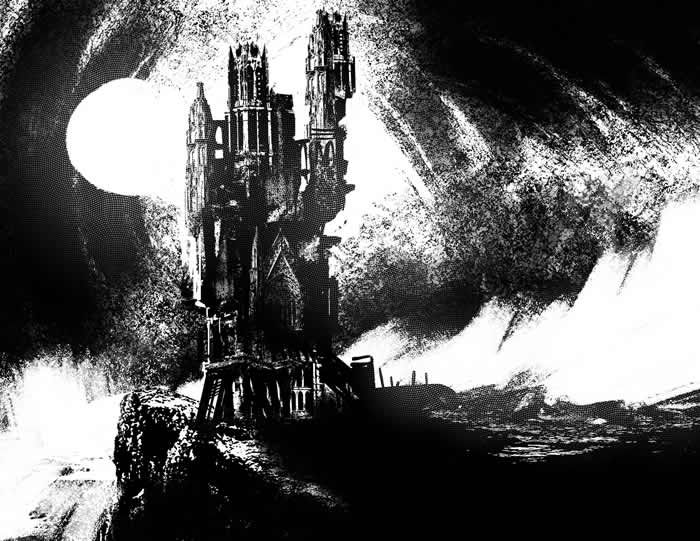
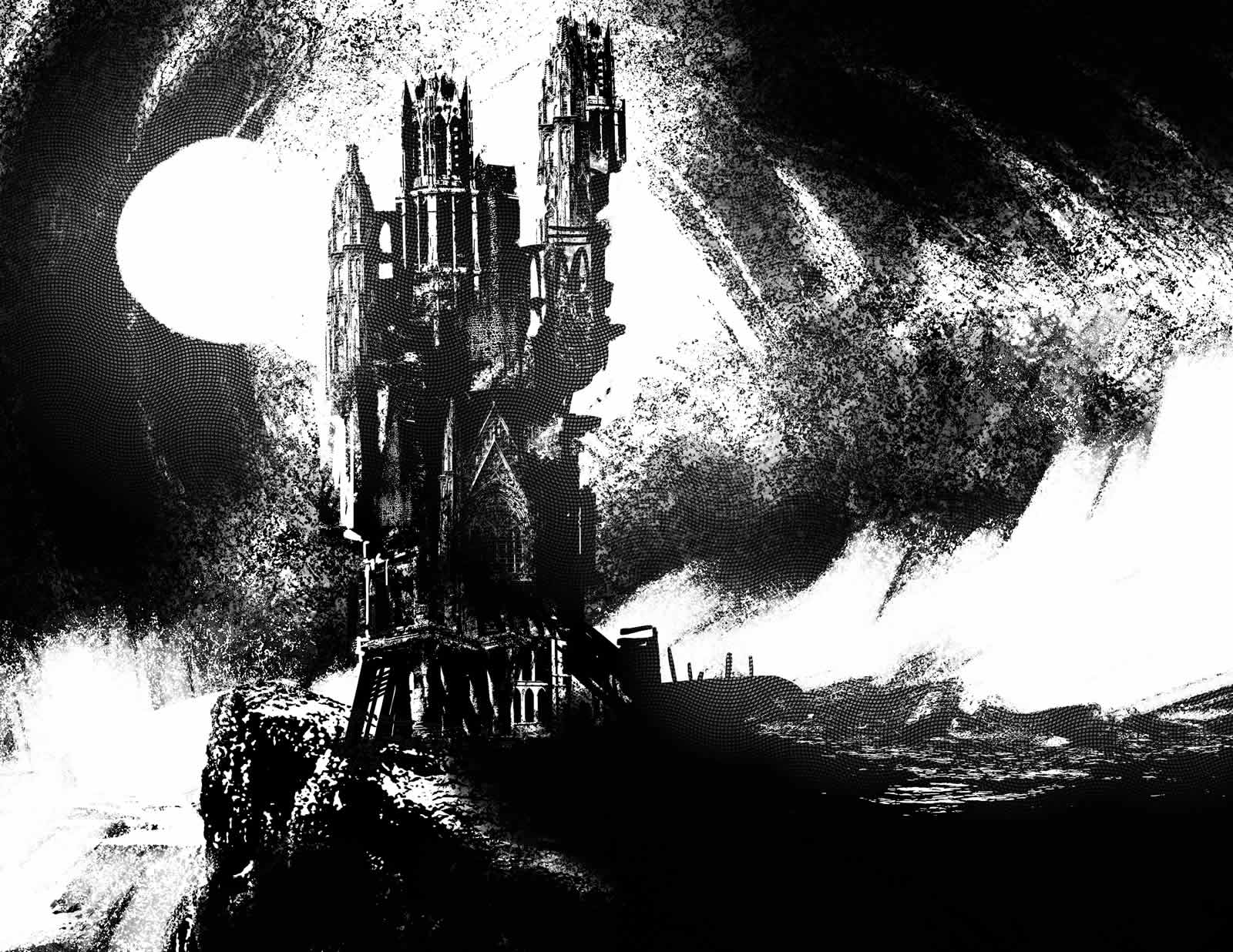
SECRETS AND CLUES
-
The caravan that the players found was initially composed of five families, but only two returned to Leda again.
-
Cassandra, Lord Fargus’ father witch, has been seen wandering the roads and the old abbey tower.
-
Some of the families have turned to the dark practices in a desperate attempt to keep evil away from their doorsteps and prevent their children from disappearing.
-
The children were in their very beds when, without a sound or leaving a trace, they disappeared. Some even did it while they slept in the arms of their mothers. No one witnessed how; they were there a moment, disappeared the next.
-
Rumors say the priests that erected the abbey gouged their own eyes out. They were worshipers of the night. The long robes they wore never let this gossip to be proven.
-
Travelers swear to have heard the cries of children echo in the deep whispers of the cliffs near the abbey at dawn.
-
Elders speak poorly of Lord Fargus and his father. They recall the great hunger of ten years ago with knots in their throats. Somehow, they are ashamed and don’t want to talk about what happened that night.
-
Some remember that Cassandra used to feed the beholder with fish, but since the fishermen were against sharing their food with the creature, they let its share rot on the beach before giving it to the witch.
-
If asked, no villager will deny having seen Lord Fargus’ father hanging from the great oak tree in front of the abbey, but there will not be a single one who admits having taken part in the lynching that night.
-
According to the customs of their order, the priests were buried into the seas. Some of the village elders say that when the last priests sunk, that’s when the sea began to give rotten fish.
CUSTOMIZING THE ADVENTURE
You can easily customize The Tower of the Beholder by replacing Lord Fargus of Leda and his father with NPCs from your existing campaign.
The villagers with whom the players initially bump into on the road (Oskar and Westbrook) can also be personalized by relating one of them to some of your players, either by blood or by past encounters. Perhaps the nephew of one of your players is the son of Oskar or the son of Westbrook and has now been lost along with the rest of the children.
Maybe Oskar or Westbrook sent for the characters after the disappearances began. Perhaps one of the younger brothers or sisters of one of your players or even one of their children has disappeared.
The possibilities to relate the events of the story to your players are endless.
Cassandra, Lord Fargus’ sorceress, can also be customized to belong to a sorceress or wizard from your own campaign.
The dark priests of the abbey can also be a starting point for a more custom and familiar adventure. They can belong to an Order that is already well established in your campaign.
BEGINNING THE ADVENTURE
The great red flame of sunset burns slowly over the hills to the South of Whitesparrow. A gloomy mist covers the road ahead, where two wagons visibly damaged by swords and arrows, block the path.
A thin man with worn clothes and the skin hardened by the sun advances towards the players along with a child of no more than fifteen summers with caution and distrust. The curved blade of the man, fully extended. The dagger the boy clings tightly to, shaking.
Behind them, wives hurry their daughters back inside the wagons in whispers, never taking their eyes off the players. The children faces are expressionlessly tired, eyes that have seen too much of men’s hate, staring at nothing and taking in everything at once.
One of the wheels has given up against the stones of the road and a second man busily pushes himself to give it back its shape before night falls.
Family one: Oskar (husband), Thendra (wife), Arthur (eldest son), Soren (son), Michail (son)
Family two: Westbrook (husband), Choli (wife), Joslyn (eldest daughter), Edmund (son), Maribel (daughter)
At the south of Whitesparrow, the party crosses path with a caravan of two families of fishermen fixing the wheel of one of their wagons. By the state of their belongings, and the tired of their horses, it is clear that they have ridden all night long, enduring more than one attack on the road.
As the party gets closer to the wagons, the men reluctantly try to keep them away from their families.
Diplomacy will ensure that a peaceful encounter can be held. A sword-to-sword conversation will be the most that players can get from these people.
In case things get a tad too loud, the women of both families can persuade the men not to risk their lives unnecessarily by escalating things any further.
During the conversation, the party will learn that the families are heading back to the Coast of Leda, a small village of fishermen from where they are originally from after unsuccessfully trying to relocate to the nearby town of Imuria, north of there.
The men will bitterly tell the party that, like many of the fishermen who try to flee from Leda, they too have been met with nothing but hostility in nearby towns. Now, left with no other option to survive through the winter, and against their better judgment, they are heading back to Leda.
As the talk progresses, the fishermen will reveal why many try to escape Leda: for the past two years, the youngest children of each family have begun mysteriously disappearing from their mothers’ beds.
Rumors of the curse travel fast through Whitesparrow.
Fearing the curse, some of the families have been imprisoned after trying to settle outside Imuria. Others have been burned alive along with all their belongings.
For the missing children, they blame Lord Fargus, sovereign of these lands. They consider him as useless as his father was once in life (though they won’t reveal much more about what’s happening than that).
At each opportunity of the conversation, they warn the players to turn around and return where they came while there is still time.
People throughout Whitesparrow do not look too kindly at those who walked through Leda, and if they spend too much time there, they risk the fate of their people becoming theirs.
Once the talk is over, players can approach Leda to learn more about the curse and Lord Fargus, although many will choose not to talk to them out of fear and shame.
The first thing that surprises the players is the incredible rotten stench that floods the narrow streets of the small fishermen village.
Like the families they came across before, those who stayed in Leda will also blame Lord Fargus for the curse. Hunger and death loom over every family, no one is safe. The situation feels as if it was spiraling out of control; is not only that the children are disappearing, but the fishermen can’t feed the rest of their families. Something that happened when Lord Fargus’s father was alive began to happen again: the fishing is going sour.
“The great hunger” the elders call it. Back when his father was alive, it drove the people of Leda to desperation; they ended up burning the abbey down and hanging Lord Fargus over the great tree that grows nearby. Rumors say that, if the situation doesn’t change, the same tree that saw the father hang, might also claim the son’s life.
Eventually, the party gets approached by one of Fargus’ men: a tall, fierce-looking warrior with a troubled frown who invites them to his Lord’s mead hall (after forcing them to leave their weapons at the door).
Inside, Lord Fargus introduces himself and says his men told him about the outlanders who were asking questions about the curse. He is not convinced that what is happening to the village its a curse at all; but in a conspiracy. The children, the fishing souring; it all reeks to dark forces plotting against him.
Fargus strongly suspects Cassandra, the witch who lived in the tower of the old abbey. When the tower was burned, nobody saw her body, they only hear her screams. Now, many travelers have started to rumor having seen her by the cliffs. Not long ago, Fargus sent six of his best men to investigate the tower, but many moons have passed and none of them has returned.
Someone it is trying to take him his lands, the problem is that he doesn’t know who. Not long ago he sent out six of his best men into the Tower of the Beholder. There, Fargus suspects the true secret for the disappearances of the villager’s children hides. Moons have gone by, and none of his men has returned.
The tower, a massive structure twenty times taller than the largest tree of the High Forest, leans crookedly at the top of a cliff next to the ruins of his father’s old abbey.
Cassandra, royal sorceress for Lord Fargus’ father, kept the beholder under her power to guard her master’s lands during the Rhainne campaigns. When the men of the village and Farguns himself answered the horn of war, far beyond the hills of the east, it was the witch’s abomination that kept his father’s enemies at bay.
With most of the food being sent away to the front lines, Fargus’ father didn’t realize of his mistake when he let the witch poison his hear with the idea of using the beholder as guardian of the village; the beast feeds itself with the hunger of ten families.
Soon, the fishermen began protesting having to give most of their food to the Beholder. The bad blood grew to the point where they left the part that belonged to the Beholder to rot under the midday sun of the beach, in an attempt to poison him. To the dismay of the villagers, the rotten fish became a delicacy for the creature.
It was not long before all the fish came out rotten from the fishermen’s nets. The seas were punishing the villagers for feeding the aberration.
With the sea cursing their fishing, there was no more food left to feed the village, and with most of the fishermen gone to the war, the villagers’ hunger grew into anger and desperation. Blood was shed. The crowd was unforgiving.
Even though it was the only thing that kept them safe, that night, the villagers blaze the tower on fire, killing the monstrosity that soured their food.
In the middle of the night, at the light of torches, death spreads quickly. It wasn’t until Fargus’ son got word of the revolt and hurried back from the battlefront that the madness stopped.
But by then it was already too late; his father hung from the old oak tree. Half of his men lay slaughtered around the burnt ruins of the abbey.
Fargus was now Lord of the coasts of Leda.
With the beholder dead and the witch gone, Fargus saw no other choice to protect his people than surrendering part of his father’s domains to his enemies. The sea gave them abundance again. Peace was no longer a longing in the heart of the fishermen.
Winters went by. Now, a new evil with a stench to the past descends like a thick bank of fog over the coasts of Leda. The children are missing from their beds. Fishing is rotting again.
What’s worse: fearful by the disappearances, some of the villagers have begun to put their faith in charlatans and the dark arts, steering away from the teaching of the stars his father worked so hard to maintain.
For Lord Fargus, everything points to the witch and the tower of the old abbey. He promises what remains of his fortune if the players can help him unravel the mystery.
FIGHTING THE CHILDREN
If it comes to that, this adventure includes a battle against the creatures that were once the villagers’ missing children. We include the names of some of them and to whom they belonged before turning into despicable monsters. Feel free to customize one or more of these children to be a little brother, son or nephew of one of your players.
NOTABLE LOCATIONS
LEDA
Area Aspects: small fishermen village, an old abbey in ruins next to a crooked watchtower at the edge of a cliff. Great black tree near the abbey.
The sea wind blows putrid in Leda. A light rain continually falls over its sharp cliffs of black granite. Its air, eerily warm for a coastal village, hurts the lungs when breathed.
Below the precipice where the abbey and its tower are, as if they were the ribs of long-dead animals, the broken carcasses of forgotten boats lie half-buried in the lugubrious sands of the beach. A testament to the village’s misery.
The small houses, covered in a greenish mold, stretch chaotically through the rocky landscape of southern Whitesparrow as if they had sprouted from the rock itself.
With doors and windows covered up by cheap talismans bought to travelers and bums, Leda’s villagers have put their faith into the dark arts in search of protection for their children.
Besides the occasional laughter that reeks of despair and madness, there are no sounds of life left in the small village, only the constant complaints of seagulls looming over large pools of fetid fish. Fish that no merchant would consider buying, not even to feed the pigs.
Leda its located on the south coast of Whitesparrow, near the frontier between the town of Imuria and the Longhammer Kingdom.
Despite covering a fair amount of terrain on the rocky coast of Whitesparrow, Leda it’s relatively small. There is no fertile ground there, only a few wide trees the fishermen use to build and repair their boats.
The village’s most prominent landmark is its abbey’s watchtower, where a Beholder infamously lived during the Rhainne campaigns. The structure, a huge black stone tower that stood on the highest cliff of Leda, was used by priests to study the movements of the stars.
Despite being relatively hidden, Leda its no stranger to raids by either sea or land. Pirates try to assault the fishermen as often as bandits have attempted to occupy its roads, but the abbey and its watchtower have always been there to protect them.
ABBEY
Area Aspects: cliff, uphill narrow path
The path from the outskirts of the village to the abbey it is dangerous, hard to walk. It leads to a narrow passage that spirals uphill against Whitesparrow’s famous ebony coast, where its ruins are.
The rocks of the cliff where it was built are as sharp and slippery as an elvish blade. The winds blowing on the trail that leads to it are so strong that even the most experienced travelers don’t find the courage of going through it by only using the feet.
To reach the abbey of Leda, like the blind monks who built it, one must crawl there.
The high walls of hand-carved stone blocks that once protected it fell helpless before the whims of the villagers and time. Beside it, a half-burnt candle raises over the mist; the tower of the Beholder. Crooked to one of its sides after part of the abbey’s walls fell over it, the old watchtower shows the countless scars of old sieges.
As if it was clinging to the coast of Leda by a will of its own, the tower of the beholder looks like it is about to collapse off the cliff at the slightest fell of one of its bricks.
SHATTERED DOOR
Area Aspects: gargoyle sticking out its tongue, broad ironbound wooden door (shattered), poisonous vines.
The door is of a strong ironbound oak as dark as the coal of dwarfs. Among the pieces of the door that are still standing, the door knocker sticks its thick gargoyle tongue out in a grotesque grimace of scoff contempt.
In the past, the entrance to the ruins of the abbey was blocked from the outside by two large pieces of red oak. Now, the poisonous vine that creeps all through the door and the stone walls its enough to keep marauders away from its secrets.
Since Leda’s sorceress vanished from her tower, the magic that once protected the abbey’s entrance has slowly faded away over the years, but not entirely.
Some of it still lingers there, like an invisible mist to the eyes and senses, allowing the poisonous weed to grow uncontrolled, wild, and giving life to Jerry, an old door knocker with an extravagant taste for long conversations.
If the party can withstand the brass ornament’s dry sense of humor, they will have a unique opportunity to learn more about the night of the lynching of Fargus’ father through the eyes of a privileged witness.
The poisonous vine covering what’s left of the door is particularly dangerous: it can lash out against creatures passing close by and even trap them.
Any person or creature attempting to go through the shattered door without protection from the poisonous vine must succeed on a DC 13 Constitution, or take 7 (2d6) poison damage.
If someone gets stung by the vine, it will be poisoned so for around twenty-five to thirty-five minutes.
A character with a medical background can spend five minutes to aid the poisoned victim and attempt a DC 12 Wisdom (Medicine) check.
If the attempt succeeds, the afflicted wound will no longer be poisoned: the victim will heal over time.
The poisonous vines cover almost the entire shattered door, allowing the party to partially see what’s inside, but not step inside the abbey without getting rid of it first.
TOWER HALL
Area Aspects: Dim light, signs of a battle on the floor, burnt torches, spiders.
Unlike in the village, where it is breathed warm, the air trapped within the tower of the beholder it is as cold and damp as the one of a crypt. Sun isn’t allowed beyond its thick hand-carved bricks; it has been barred.
The priests that erected the tower were worshipers of the night. They blinded themselves by tearing out their own eyes. Their gods, swollen lumps hiding in the void of the stars, granted them their darkest wishes.
Spurts of blood from severed limbs that are not there. Scratches on the wood flooring from swords that missed their target. Signs of a recent battle.
The staircase, which stone steps are barely wide enough for one person to climb it at a time, disappears between shadows and a thick curtain of cobwebs.
The spiders that lurk free in the dark have the size of a small pig and move in groups of five or less. They can climb difficult surfaces without needing an ability check (spider climb). While in contact with their web, even when it’s a broken one, the spiders can know the exact location of any other creature in contact with their web (web sense). While on their web, spiders are fast and can easily ignore the restrictions caused by webbing (web walker).
LIBRARY FLOOR
Area Aspects: books of all sizes and shapes, some burnt, some untouched and still on their lecterns, spiders, three zombies, a Rust monster and a Mimic, hidden in a large bookcase. Aleph symbol on the floor.
It would be impossible to know for sure how many books in the arcane arts the library of the old tower used to house, only that rage and fire weren’t enough to rid the world from their madness.
Among the burnt papyruses and the piles of greenish ashes from the skin of the strange creatures that the priests’ used to bind some of their books’ with, a small number of their most unholy tomes managed to escape the claws of fire. They rest there still, on their lecterns, undisturbed.
With thick pages made out of the dry skin of the oldest priests of the order, these books carry secrets no sane man should dare to know. Texts that date back to a time where the scribes of the monastery had discovered the true nature of the dark. Thankfully, the priests wrote them in a tongue only a man without eyes can read.
In addition to the spiders mentioned in the tower hall, three zombies are discovered in the library floor (Lord Fargus’ lost men, still wearing their light armor) along with two Monstrosities: a Rust Monster and a Mimic that hides in a large bookcase near the back wall.
An aleph is a cardinal point from where one can see all the points of infinity from the same angle, simultaneously, without distortion or confusion. Those who dare to see through an Aleph invoking one, often end up losing their minds or hurting themselves due to the overwhelming nature of the experience.
SORCERESS STUDY
Area Aspects: burnt books on magic, mess, one deep gnome, one Shrieker, a Skeleton, and a Giant Centipede lurk in the shadows after having escaped their glass prisons.
A hurricane couldn’t have made a better job ravaging the witch’s study than the mess the hungry fishermen did. And they were remarkably hungry.
Under the wreckage of a large turned over bookshelf, countless glass cases of all sizes and shapes hold creatures that ought to be under someone’s boot or burning on a stake. The glass cases stack high under broken wooden shelves in a grotesque display of the arcane, worthy of the Herald Holdfast’s museum of wonders.
Some of the witch’s aberrations are long dead. Others, clumsily try to free themselves from the spell that binds them to an existence of misery, even after all these years. But it is the ones that are not are there that stand out the most. Large, thick glass cases, lie broken on the floor. Their exploded glasses speak of things that should only have crawled, but for some reason, have broken free and learned how to walk.
One deep gnome, one Shrieker, a Skeleton, and a Giant Centipede lurk in the sorceress’ study.
BEHOLDER’S LAIR
Area Aspects: open vertical space, greenish magical bonfire, a blind beholder.
The last six floors of the tower have been purposely collapsed to leave enough space for the Beholder creature to float free.
Although it has been blinded on all its eyes by the flames of the villagers almost ten years ago, in the enormous eye of the aberration, hell can be seen. His mouth and nose breathe fire in constant anguish. His disfigurement only makes his features more hard, more terrible.
There is no longer any trace of sanity in the monstrosity, only rage and a feeling of deep sorrow for the loss of their children. It bounces stupidly against the black stone walls, breathing so heavily that the very tower seems to be breathing with it.
Beneath the creature, the sons and daughters of the villagers gather around a sickly bonfire. Its faint greenish light spills over the little ones as they move awkwardly in circles worshiping the Beholder. A kind of dance so horrible that it could well have been taken from the darker passages of the second forbidden volume of Wolfhar the Damned.
CONCLUDING THE ADVENTURE
Besides defeating a blinded by hatred beholder with a ten-year bloodthirst, the party must decide what to do with the children.
Will they murder them for what they have become? Will they return them to their parents? Will they try to break them free of their curse? Perhaps by killing the villagers, so that the curse can end and they can save the children and the future of Leda?
Will they try to summon Cassandra with one of the books from her Library? Or will Fargus allow the children to live in the tower, in secrecy?
EXPANDING THE ADVENTURE
The tower can have as many floors as you want.
Each floor can be filled not just with traps and foes your players can overcome, but with secret passages or magic stairs that lead from one floor to another in the tower.
That alone will create a vertical maze your characters can explore for as long as you want while having an “escape clause” at hand you can exploit any second by having them travel instantaneously to the witch’s study after walking up a flight of stairs.
That alone would create a vertical labyrinth that your players can explore for as long as you want, while at the same time, give you an “escape clause” at hand that you can conveniently exploit at any time by making them travel instantly to the witch’s studio (in case they get impatient).
There can even be a dungeon underneath the tower that extends to the abbey itself, where the beholder is hiding. Or, you can have it hidden on the tower’s roof, or in one of the previous floors to Cassandra’s study, or anywhere you want!
You can also have a maze of poisonous vines outside the tower and you can even have Lord Fargus’ father’s spirit appear at the oak tree where he was hanged, maybe even giving some clues or valuable instructions in getting through the tower’s maze.
It is also possible that the story of Lord Fargus doesn’t end with this adventure. Depending on how your players end this story, you can have his father’s spirit haunting the people of Leda for having lynched him. You can even have your players fight Lord Fargus’ disembodied spirit with the help of Cassandra!


